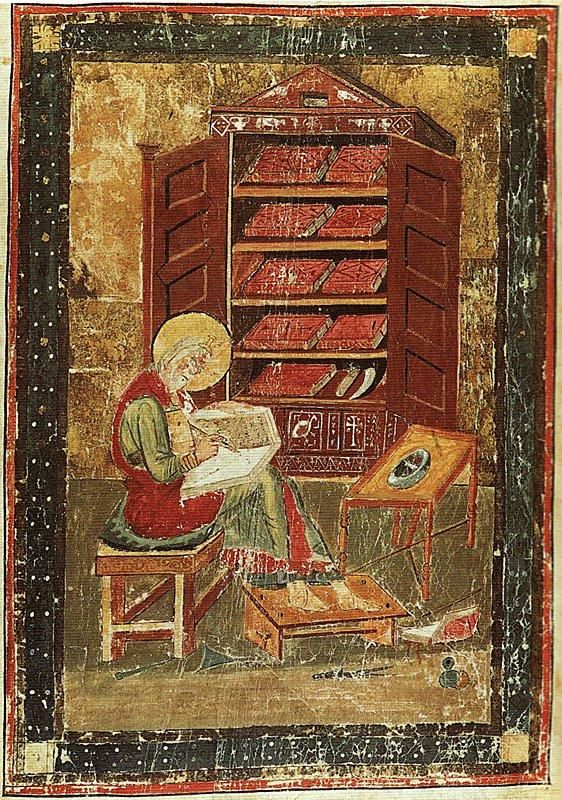The intellectual climate had changed, and I saw that I needed to situate my work as an historian in contemporary animal theorizing in order to be responsive to the interpretive richness of this new cultural moment in scholarship and to develop a vocabulary that might enable a reading “otherwise” of ancient Christian texts that feature animals.
Read MoreWhat can pre-modern Muslims tell us about the Hebrew Bible?
King Ahashverush and the maidens, Shahin, Ardashir-nameh, Persia, 2nd half of the 17th century (Berlin, Staatbibliothek Preussischer Kulturbesitz)
King Ahashverush and the maidens, Shahin, Ardashir-nameh, Persia, 2nd half of the 17th century (Berlin, Staatbibliothek Preussischer Kulturbesitz)
“There is evidence that Persian Muslims and Jews shared notions about the story that united them on the one hand and distinguished them from their coreligionists elsewhere on the other.”
Read MoreCreating Christian Marriage in Early Islamic Arabia
"Do Christians have to marry in churches? Historically, many Christian theologians have said “yes.” But they haven’t always. It wasn’t until the tenth century, for example, that the Byzantine emperor made a church ceremony a required element of marriage for Orthodox Christians. Nor was Constantinople at the forefront of the matter.”
Read MoreDissertation Spotlight | Story and Sacrifice: Ritual, Narrative, and the Priestly Source
Liane M. Feldman, “Story and Sacrifice: Ritual, Narrative, and the Priestly Source,” PhD Dissertation, University of Chicago, 2018.
Read MorePaul, the Gentiles, and the Other(s) in Jewish Discourse
The Apostle Paul in St. Sophia of Kyiv via Wiki Commons.
The Apostle Paul in St. Sophia of Kyiv via Wiki Commons.
Cavan Concannon responds to Adi Ophir and Ishay Rosen-Zvi’s book, Goy: Israel’s Multiple Others and the Birth of the Gentile in the AJR review forum.
Read MoreThe Goy: A Synchronic Proposal
“Moses receiving the law” in the Basilica of San Vitale is a church in Ravenna, Italy,
“Moses receiving the law” in the Basilica of San Vitale is a church in Ravenna, Italy,
Christine Hayes responds to Adi Ophir and Ishay Rosen-Zvi’s book, Goy: Israel’s Multiple Others and the Birth of the Gentile in the AJR review forum.
Read MoreEthnic and Cultural Identities in the Rabbinic Goy Discourse
Isaac, Jacob, and Esau at Cathedral of Monreale, Italy via Wiki Commons.
Isaac, Jacob, and Esau at Cathedral of Monreale, Italy via Wiki Commons.
Yair Furstenberg responds to Adi Ophir and Ishay Rosen-Zvi’s book, Goy: Israel’s Multiple Others and the Birth of the Gentile in the AJR review forum.
Read MoreThe Perils of Polarization
Cynthia Baker responds to Adi Ophir and Ishay Rosen-Zvi’s book, Goy: Israel’s Multiple Others and the Birth of the Gentile in the AJR review forum.
Read MoreGoy: An AJR Forum
The AJR review forum of Adi Ophir and Ishay Rosen-Zvi’s book, Goy: Israel’s Multiple Others and the Birth of the Gentile. With responses from Cynthia Baker, Yair Furstenberg, Christine Hayes, and Cavan Concannon.
Read MoreWhy Goy?
Adi Ophir and Ishay Rosen-Zvi open the AJR review forum of their book, Goy: Israel’s Multiple Others and the Birth of the Gentile.
Read MoreAffect and Early Christian Identity
Papers from the 2018 Society of Biblical Literature’s review panel on Maia Kotrosits’s Rethinking Early Christian Identity: Affect, Violence, and Belonging (Fortress, 2015).
Read MoreJob, White Privilege, and the Case for Reparations
Nevertheless, I characterize the book as more protean. It resists reductive readings, always offering a counter-text to any interpretation (including the one in this essay.)
Read MoreDissertation Spotlight | Magical Practices and Discourses of Magic in Early Christian Traditions: Jesus, Peter, and Paul
I argue one must take into account not only what magic is said to be, but also what magicians do. There is a reason, after all, that these practices are the ones against which Apuleius was compelled to mount his defense.
Read MoreRethinking Early Christian Identity: A Response
Maia Kotrosits responds to the review forum on Rethinking Early Christian Identity: Affect, Violence, and Belonging (Fortress, 2015).
Read MoreRethinking “Early Christian Art”
Jonah being thrown into the Sea. Catacomb of Saint Peter and Saint Marcellino, Rome, Italy, via wikicommons.
Jonah being thrown into the Sea. Catacomb of Saint Peter and Saint Marcellino, Rome, Italy, via wikicommons.
Eric Smith responds to Maia Kotrosits’s Rethinking Early Christian Identity: Affect, Violence, and Belonging (Fortress, 2015).
Read More"What Has Affect Theory to do with Acts?": Testing Methodological Boundaries In Acts Scholarship
Teresa Calpino responds to Maia Kotrosits’s Rethinking Early Christian Identity: Affect, Violence, and Belonging (Fortress, 2015).
Read MoreThe Codex of Feeling: Affect Theory and Ancient Texts
Donovan Schaefer responds to Maia Kotrosits’s Rethinking Early Christian Identity: Affect, Violence, and Belonging (Fortress, 2015) at the 2018 SBL review panel.
Read MoreEngaging with Intersectionality and 1st-2nd c. "Judaism"
Shayna Sheinfeld responds to Maia Kotrosits’s Rethinking Early Christian Identity: Affect, Violence, and Belonging (Fortress, 2015) at the 2018 SBL review panel.
Read MoreAntiquity on Display: The Armenia! Exhibit at the Metropolitan Museum of Art
This exhibition aims to showcase Armenia as an artistic civilization in its own right rather than a postscript to the more prominent and the better-known achievements of Byzantium or Near Eastern cultures.
Read More

















